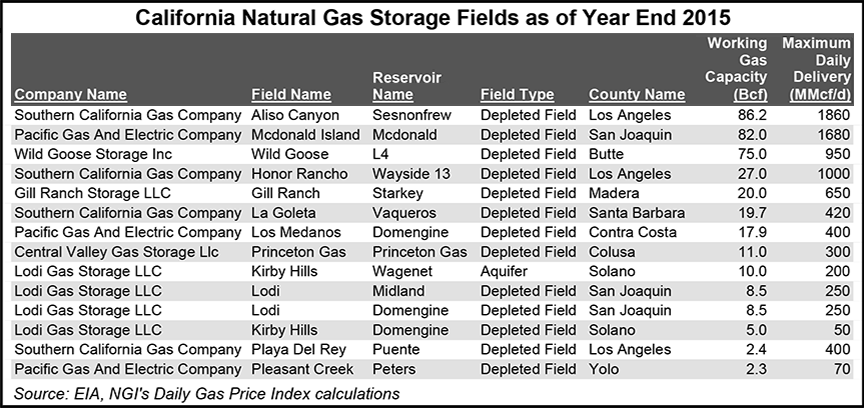Regulatory | Infrastructure | NGI All News Access | NGI The Weekly Gas Market Report
California’s Second-Largest Gas Storage Field Closed for Leak Repair, Testing
California’s second-largest underground natural gas storage field — Pacific Gas and Electric Co.’s (PG&E) McDonald Island in Northern California — has been closed following the discovery of small leaks around some of the 87 gas storage wells at the 81 Bcf capacity facility.

The storage field in San Joaquin County could be closed until September while the “very tiny” leakage is assessed, repaired, and all of the wells are tested and certified as safe by the state Division of Oil, Gas and Geothermal Resources (DOGGR).
PG&E voluntarily shut its injection and withdrawal of gas at the facility, and there has been no safety, environmental or service impacts, according to a PG&E gas utility spokesperson in San Francisco. A DOGGR spokesperson late Monday told NGI that there have been no orders from the state for either the shutdown or the ongoing well testing.
Ken Harris, the state oil/gas supervisor and head of DOGGR, sent a letter to PG&E outlining the state’s testing protocol (see Daily GPI, March 29), “but no formal order has been issued,” the DOGGR spokesperson said. In the letter, Harris called the leaks’ emissions “low level” and said flyover measurements placed the release volumes at 236 kilograms/hour (kg/hr) to 763 kg/hr, compared to peak releases measured at the Aliso Canyon storage well leak of more than 60,000 kg/hr earlier this year.
“Surveys by both the San Joaquin Air Resource Board and PG&E show only minor natural gas seepage from the field and wells,” the DOGGR spokesperson said.
Although the source of the leak has not been determined yet, a PG&E spokesperson said it doesn’t appear to be related to a particular well.
With minimal venting, engineers report that the leak appears to be underground, seeping through the sand layer, according to the DOGGR spokesperson. Ten wells showed detectable methane emissions and two wells have been isolated from the reservoir. “We are taking every precaution to prevent a leak like the one at [Southern California Gas Co.’s] Aliso Canyon [see Daily GPI,Feb. 18],” the DOGGR spokesperson said.
Given the number of wells with detectable emissions, DOGGR directed PG&E to test all wells at McDonald Island, Harris said in his June 30 letter.
PG&E officials said that they detected the leak or leaks during inspections ongoing of all the storage wells in the utility’s three underground storage fields, this one at McDonald Island being by far the largest.
Located on a man-made island in an unpopulated area near the Sacramento-San Joaquin River Delta, McDonald Island is capable of providing nearly 25% of Northern California’s gas on days when demand is high, according to PG&E. The current shutdown, however, has no impact on the utility’s service this summer, the utility spokesperson said.
The closest housing to the storage field is about 10 miles away, according to DOGGR, which confirmed that PG&E has notified the surrounding community about the incident and ongoing testing via its Pipe Ranger website.
In the meantime, in the southern half of California, Aliso Canyon remains closed as testing continues on its 114 storage wells. Residents and activists recently resumed their call for the facility’s permanent closure (see Daily GPI, July 7).
© 2024 Natural Gas Intelligence. All rights reserved.
ISSN © 1532-1231 | ISSN © 2577-9877 | ISSN © 1532-1266 |
